Hooke has extensive experience with CIA, one of the most commonly used animal models of human rheumatoid arthritis. The CIA model is usually run in DBA/1 mice, but the disease can also be induced in B10.R111 mice, B10.Q mice, and Lewis rats.
RA is an autoimmune disease affecting primarily joints, but also connective tissue in the heart, blood vessels, lungs, eyes, skin, and kidneys. RA affects more women than men (~2:1). Joint inflammation is characterized by pain, swelling and stiffness, development of adhesions, erosion of joint surfaces, bone resorption, loss of function and joint deformation.
Approved treatments for RA include:
The joint inflammation which develops in CIA resembles inflammation in human patients with RA. Therapeutics which reduce RA in human patients (such as those listed above) are also efficacious in CIA. Compound efficacy in the mouse CIA model has excellent predictive value for efficacy in RA.
CIA is mediated by both T cells and antibodies (B cells). Macrophages are believed to play an important role in mediating tissue damage during disease development.
CIA is induced by immunization with type II collagen emulsified in Complete Freund's Adjuvant (CFA), followed by a booster immunization with type II collagen emulsified in Incomplete Freund's Adjuvant (IFA). Three to four weeks after immunization, inflammation develops in mouse paws.
Treatment can be initiated either at the time of immunization (prophylactic treatment), when 10-20% of mice show initial signs of disease (semi-therapeutic treatment), or as each mouse develops disease (therapeutic treatment).
This model is 40 to 50 days long.
CIA induction and development

Treatment starts at immunization and continues for 6 weeks. Mice are assigned to groups in a balanced manner to achieve similar weight at the time of immunization.
The results below are from a prophylactic CIA study in DBA/1 mice treated with vehicle and positive controls dexamethasone and methotrexate.
Typical results (prophylactic treatment)
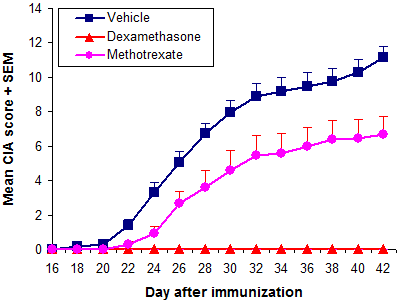
| Treatment | CIA incidence | Median day of onset (all mice) |
p value (onset) |
End score ± SD |
p value (end score) |
End weight (%) ± SD |
p value (end weight) |
|---|---|---|---|---|---|---|---|
| Vehicle | 100% | 22.4 ± 0.6 | 11.1 ± 2.6 | 87.4 ± 5.3 | |||
| Dexamethasone | 0.0% | n/a | <0.0001 | 0.0 ± 0.0 | <0.0001 | 84.9 ± 4.8 | 0.2411 |
| Methotrexate | 86.7 | 26.0 | 0.0004 | 6.7 ± 4.2 | 0.0015 | 93.1 ± 6.5 | 0.0128 |
Treatment starts at disease onset, with rolling enrollment as each mouse develops disease. Treatment continues for 14 to 20 days.
Mice are distributed to groups in a balanced manner, to achieve a similar distribution of severity and day of onset in each group. Mice with late onset are excluded. Very consistent groups yield very tight results.
Shown below are typical results from therapeutic CIA studies in DBA/1 mice.
Therapeutic treatment with dexamethasone and methotrexate
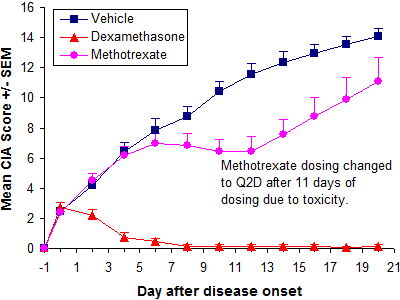
| Treatment | Day of onset ± SD |
Score at onset ± SD |
Score 14 days after onset ± SD |
p value | End score ± SD |
p value | End weight (%) ± SD |
p value |
|---|---|---|---|---|---|---|---|---|
| Vehicle | 27.0 ± 1.4 | 2.5 ± 1.2 | 12.3 ± 3.0 | 14.1 ± 2.1 | 90.5 ± 6.0 | |||
| Dexamethasone | 26.9 ± 1.0 | 2.7 ± 1.8 | 0.1 ± 0.5 | <0.0001 | 0.1 ± 0.5 | <0.0001 | 99.0 ± 5.9 | 0.0006 |
| Methotrexate | 27.1 ± 1.0 | 2.4 ± 0.8 | 7.5 ± 3.7 | 0.0021 | 11.1 ± 5.6 | 0.1229 | 91.7 ± 7.9 | 0.6548 |
Therapeutic treatment with anti-TNF and CTLA4-Ig
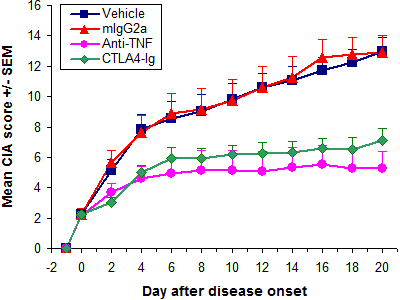
| Treatment | Day of onset ± SD |
Score at onset ± SD |
Maximum score ± SD |
p value | End score ± SD |
p value | End weight (%) ± SD |
p value |
|---|---|---|---|---|---|---|---|---|
| mlgG2a | 25.4 ± 1.4 | 2.3 ± 1.3 | 12.9 ± 3.8 | 12.9 ± 3.8 | 95.1 ± 5.5 | |||
| Vehicle | 25.5 ± 1.6 | 2.3 ± 1.2 | 13.0 ± 3.0 | 0.7210 | 13.0 ± 3.0 | 0.7206 | 93.8 ± 4.2 | 0.5150 |
| Anti-TNF | 25.7 ± 1.1 | 2.2 ± 1.1 | 6.2 ± 4.3 | 0.0012 | 5.3 ± 4.0 | 0.0006 | 104.0 ± 3.5 | 0.0001 |
| CTLA4-Ig | 25.7 ± 1.1 | 2.3 ± 1.1 | 7.4 ± 2.5 | 0.0025 | 7.1 ± 2.9 | 0.0022 | 101.1 ± 4.1 | 0.0062 |
CIA is scored blind, by a person unaware of both treatment and of previous scores for each animal. Extensive training and practice are critical to repeatable scoring of CIA.
The animal's score is the total of all four paw scores on scale of 0-16, where each paw is scored as follows:
Histological analysis is often performed at the end of the study.
Sections may be made of knees, elbows, ankles, wrists, and paws. Both the number of affected joints and the severity of pathological findings in each section are considered in histological analysis of mice with CIA.
Joints are scored for inflammation, cartilage damage, pannus formation, and bone resorption on a scale of 0 to 5 for each readout.
Typical results after therapeutic treatment with mlgG2a, anti-TNF and CTLA4-Ig are shown below.
Representative histological findings - paw sections stained with toluidine blue
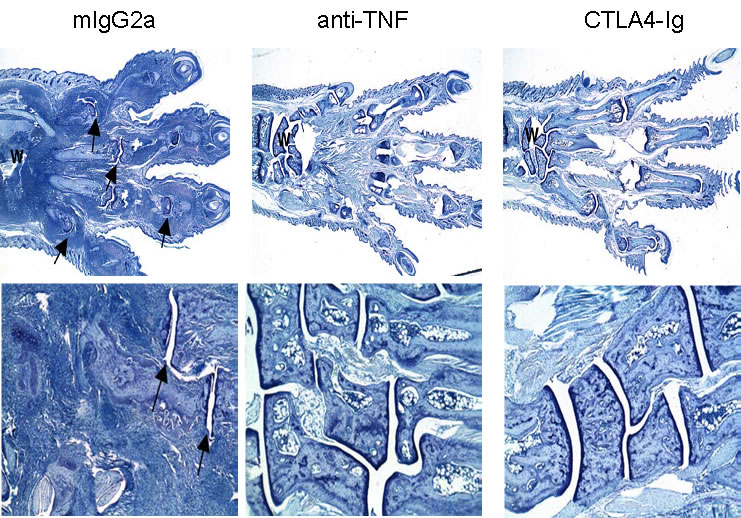
Typical histological results after therapeutic treatment
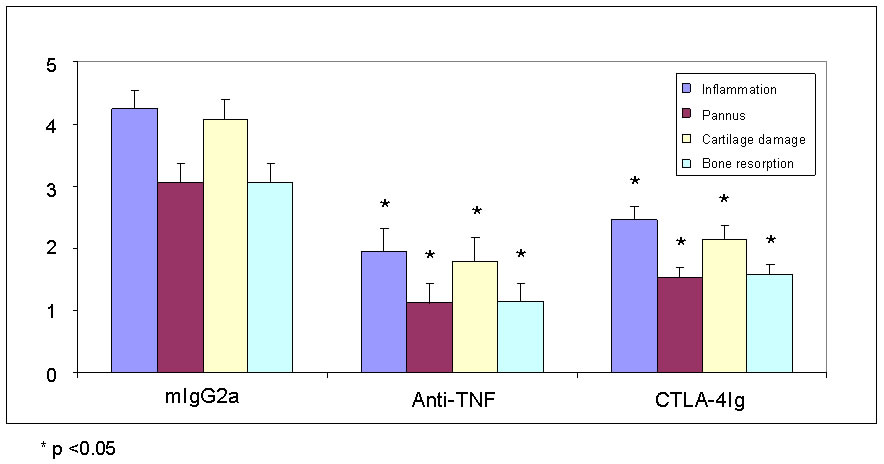
Interim results are normally reported to the customer twice weekly, starting 28 days after immunization. These include:
Final results are normally reported within 6 weeks of completing each study and include:
Histological analysis (if ordered) is normally reported within 8 weeks of completion of study.
The following are the most commonly ordered analyses in CIA studies.
Twice between Days 1 and 14 after immunization (before enrollment begins), both hind paws of all mice are measured using calipers to establish baseline values for paw thickness.
Mice are enrolled into groups when they first show paw swelling. Those mice with a swollen hind paw at that time have the more swollen hind paw measured with calipers. Those mice will thereafter have the same hind paw measured again at each CIA scoring. Mice which were enrolled based on a swollen front paw are not used for readout.
(This readout must be ordered before Day 10 after immunization.)
All four paws of selected mice are collected in 10% buffered formalin at the end of the study. Each paw is prepared and analyzed using one toluidine blue stained section.
Each paw of selected mice is photographed twice (total of 8 photos/mouse). Original camera image files are sent to the customer without editing or alteration.
Before proceeding with a CIA model study, you may want to run a short-term PK/PD assay as a first-pass screen for drugs aimed at treatment of RA: